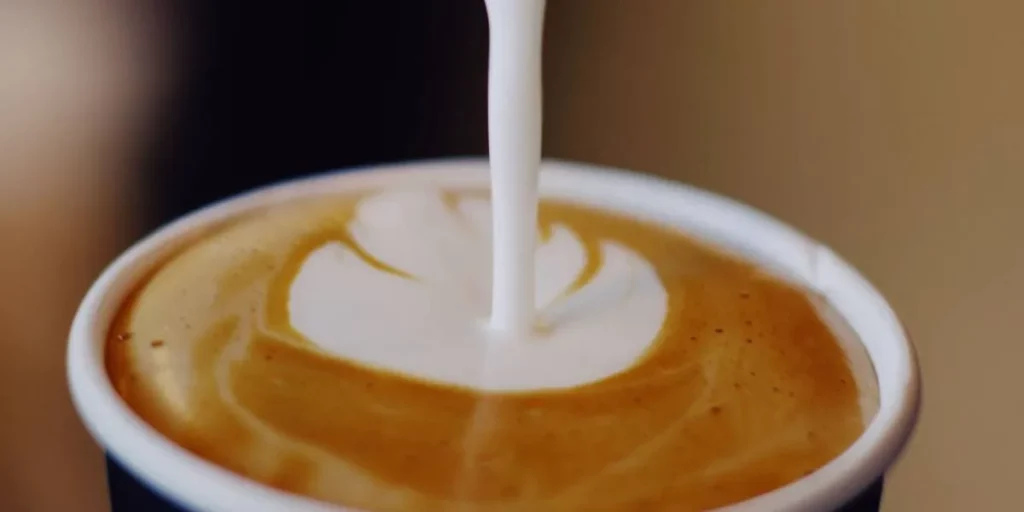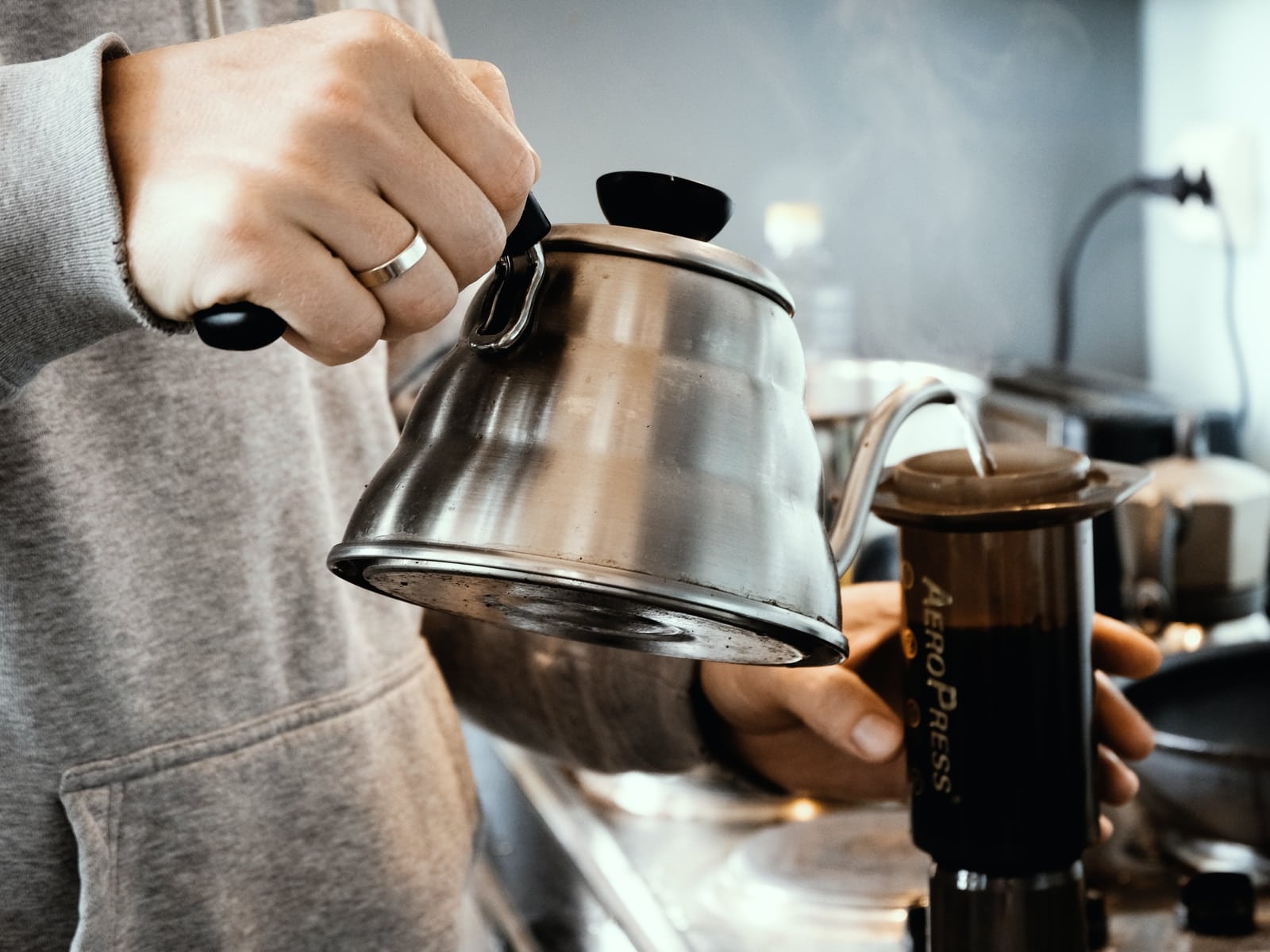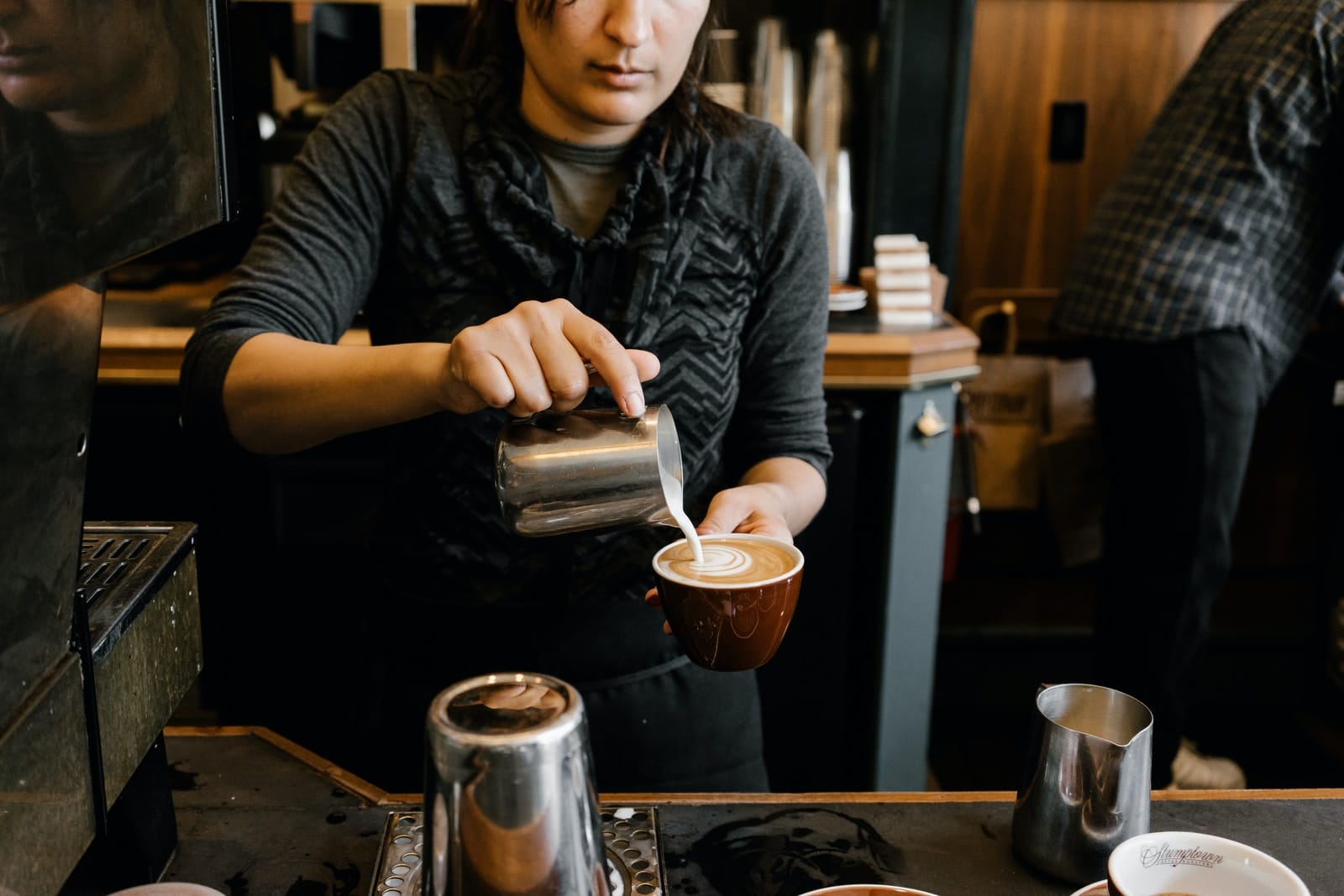If you like a nice latte in the morning but don’t want to spend the money on a home espresso machine or a couple of dollars every day at your local coffee shop, don’t worry. You can make a perfect latte right in your kitchen, and you most likely already have all you need.
Continue reading for a step-by-step guide on how to prepare a latte at home, and keep an eye out for some useful hints that will put you ahead of the game.

What is the distinction between frothed and steamed milk?
This can have a major impact on the taste of your coffee. You don’t want to combine frothed milk and espresso and call it a day. Although it may taste fine, that is a macchiato and not a latte.
So, then what is the difference? Consider this: you can have steamed milk without froth, but you can’t have froth without steamed milk. Heat is important for the survival of delicate milk bubbles. Aerating heated milk produces frothed milk.
What you need
For the espresso:
- Whole Coffee Beans
- A latte glass or mug
- Moka Pot, Aeropress, or French press
- Coffee Grinder
For the milk:
- Milk
- Thermometer (optional)
- Microwave
- Mason jar
How to make a latte without using an espresso machine

The English-speaking world refers to the popular Italian drink caffe latte, which denotes coffee with milk. It’s made with one-third of espresso and two-thirds of steamed milk, with only a thin layer of foam over the top.
Surprisingly, in Italy, lattes are almost always brewed using a Moka pot, it’s what most Italians begin their day with. Everyone has a Moka Pot, which is as important a component of kitchenware as a pasta pot.
Although any extra-strong brewed coffee will suffice, a Moka pot or an Aeropress is the best method.
You can pick any Moka Pot brands you want, and you can check out our list here.
However, if you’re looking for that crema on top. No Moka Pot will produce it, except the Bialetti Brikka
Yet, there are plenty of affordable espresso machine options in the $100 and $200 range. Also, Flair espresso maker is another good option.
Step 1: Make the “espresso.”
Water is pushed through finely-ground coffee beans at approximately 9 bars of pressure to make a perfect espresso. The high pressure is responsible for the beautiful crema that distinguishes a high-quality espresso shot.
Although this pressure is difficult to do at home using an espresso machine, you can always brew an extra-strong coffee that doubles as a great base for a latte.
- Grind the Coffee Beans
The first item on the agenda is to grind the beans. You can use whatever beans you want, but a medium-to-dark espresso roast will produce consistently excellent results.
Check out:
Best coffee beans for Moka Pot
Using freshly ground beans yields the best taste and the most influence over grind size, regardless of how you make your coffee.
Grind the coffee beans to the specifications of your coffee maker, preferably with a burr grinder. That’s because burr grinders provide a more consistent grind and do not heat the beans like blade grinders, resulting in a burnt flavor.
- Brew the coffee
Like an espresso machine, both depend on pressure to brew coffee, but neither gets close to 9 bars. The Aeropress has a maximum pressure of about 0.7 bar, while the Moka pot has a maximum pressure of about 1.5 bar.
With its Italian origins, the Moka pot is the best option for authenticity.

Nonetheless, some people stand by the French Press. Although it is not a pressure-based brewer, it can produce a robust coffee rich in oil with a mouthfeel similar to espresso.
After brewing, whatever process you use, pour 2 ounces of the strong brewed coffee inside an 8-ounce latte glass and proceed to the milk.
It’s always a good idea to pre-heat your mug. While you prepare the espresso, you should pour a little boiling water into the 8-ounce latte glass.
Step 2.1: Making the steamed milk
Steamed milk is just heated milk. However, you want to heat it enough to give it bubble strength without scalding or altering the milky taste.
You could do this in a microwave, but the stovetop gives you more control over the heat, so we suggest doing it on the stovetop.
Read our article on the Best milk for frothing
What You Need
- Milk
- Thermometer
- Small saucepan
Instructions
- Pour the milk into a small saucepan and put it on the stovetop
- Insert the thermometer into the milk to check the temperature. If this isn’t feasible, keep a thermometer handy to monitor the temperature regularly.
- Heat the milk on medium-low heat. Depending on the kind of milk you’re using, you’ll want to steam it at a specific temperature:
- Milk: 150ºF (65ºC)
- Soy milk: 140ºF (60ºC)
- Almond milk: 130ºF (54ºC)
- Stir the milk occasionally to prevent it from boiling. When the milk reaches the desired temperature, remove it from the heat and either pour it straight into your coffee or froth it.
Step 2.2: Make the frothed milk.

To discover how to make a latte without using an espresso machine, you must first master the art of frothing milk. So, if you want to make a tasty latte, pay attention to the following tricks and tips.
Read our full guide on how to froth milk without a frother
- Making Use of a Mason Jar
Pouring cold milk (about 6 ounces) into a glass jar with a sealable lid is the simplest way to make frothed milk without using a steam wand. Shake it vigorously until it’s frothy, and after that, remove the lid, put the jar in the microwave for 30 seconds, and heat it for another 30 seconds.
You can trust that it’s hot enough at this stage, but a thermometer can provide more reliable results. For the best taste, the milk should be between 140 °F and 160 °F.
If the temperature rises above 180 degrees Fahrenheit, the milk will scald and ruin your latte.
- Hand-whisk the milk
Using the Mason jar as a milk frother is not the only way to make latte foam. Any regular kitchen whisk or electric mixer can be transformed into a milk frother in a moment.
Use a vigorous back-and-forth motion with a handheld whisk. If you’re using an electric mixer, whisk the foam into the cup until it’s the right consistency.
- Make Use of Your Kitchen Tools
You can make froth for your latte recipe with various other kitchen tools, believe it or not. Before we get into the specially built gadgets for frothing steamed milk, let’s look at some tools you may already have on hand.
A conventional blender on a medium setting will suffice, as will an immersion blender on a low setting.
- Making Coffee with a French Press
Pouring cold milk into a French Press and rapidly moving the plunger up and down to froth is an equally effective tool if you have one. When the beaker becomes frothy, then you can microwave it like a jar.
- Frothing Milk with a Pitcher and a Wand
If you want to make lattes regularly, a frothing pitcher and wand are good investments. Both are currently available online for less than $30, and they eliminate some of the uncertainty and finesse from the milk frothing process.
Leave the steamed milk in the pot or the frothing pitcher. Immerse the frothing wand halfway in the milk. Ensure there is enough room in the pitcher for the foam to expand properly (it can triple in size).
Switch on the frothing wand and gradually bring it up to the surface of the milk. Return the wand to the center in a gentle motion.
Continue lowering and raising the wand at an angle for 30 to 45 seconds or until the pitcher or pan is full of foam.
Step 3: Pour the milk into the espresso
This step can be as simple or as complex as you like. Pour the heated milk into your mug and scoop any leftover foam on top if you need to get that yummy latte into your body.
Before pouring the milk into the coffee, tap the frothing pitcher on the kitchen counter a couple of times. Tapping will eliminate any huge bubbles, resulting in more consistent milk foam.
- The Art of the Latte
If you want to express yourself through latte art, now is your chance. You can experiment with various designs, and this video shows three of the most typical to get you started.
You’re more likely to succeed if you start with a design in mind and a plan for putting it into action. Just keep in mind that practice makes perfect.
First, pour the steaming milk into a container with a spout for convenient pouring. Hold the mug at right angles to the pitcher for the best range of motion.
Then, from a height of about 4 inches, pour the milk into the center of the mug. Pour slowly at first to help blend the espresso and milk and aim for a steady stream approximately the width of a pencil.
Bring your pitcher closer to the mug as you approach the end and bump up your pouring speed. And that is when art is created. Most designs incorporate a “wiggle,” where you add milk in a constant stream while moving the pitcher forth and back.

Many designs end with a “pull-through,” which splits the pattern into symmetrical halves. Bring the pitcher a few inches away from the mug and bump up the pouring speed to end with style.
- Drink
Now is the moment to relax and enjoy your latte, whether it has a lump of foam on top or a delicate tulip.
Step 4: Add any other flavorings if desired.
An authentic latte recipe consists of only coffee and milk, but there’s no reason you can’t experiment with different flavors. Add a pinch of vanilla extract, cocoa powder, cinnamon, almond extract, or nutmeg.
If you can prepare a latte at home, you can create an iced latte as well. Combine your coffee and frothed milk in a cocktail shaker with a handful of ice cubes. Shake it up and enjoy.
Lattes homemade flavored lattes
I prefer unflavored lattes. Many people, however, like flavored lattes.
- Sweetened latte—Before heating the milk, add 1-2 teaspoons of your preferred sweetener.
- Vanilla Latte—Before heating the milk and before adding the coffee, add ¼ tsp of vanilla extract.
- Chocolate/Mocha Latte—Before heating the milk, add 1-2 tablespoons of chocolate syrup.
The pros of espresso machines
If you make lattes more frequently than you prepare regular cups of coffee, an espresso machine can be a good investment for you.
This is because espresso brewed without a machine is less precise. A decent shot of espresso requires very precise water pressures and temperatures.
Using different ways to brew espresso can lead to errors in your shots instead of a perfect shot every time.
We understand that your budget and counter space may constrain your coffee equipment desires. However, if you have the resources and the kitchen space, an espresso machine can prepare your morning latte faster and easier.
Last thoughts
With this guide, you already have everything you need to make amazing lattes at home without spending hundreds of dollars on a high-end espresso machine. Getting a latte done without an espresso maker is a terrific opportunity to experiment with various flavors and techniques, whether you’re trying to save money or extend your coffee horizons.
Frequently Asked Questions
What is the best coffee for a latte?
Since the latte is an espresso-based drink, use dark-roasted espresso beans. Medium-dark roasted beans provide the finest espresso, offer a particular flavor to your latte, and add crema to it.
Is it possible to brew a latte with normal coffee?
Is it possible to brew a latte with normal coffee? Yes, but it must be a heavily brewed batch. To modify the strength of the brew, tweak the coffee-to-water ratio.
To strengthen a batch of pour-over or drip coffee, use a 1-to-15 coffee-to-water ratio or lower.
What kind of milk does Starbucks use in its lattes?
Except for the customer requests otherwise, Starbucks baristas use 2 percent low-fat milk. When milk is heated, it becomes aerated, resulting in the rich, creamy texture which all latte lovers are familiar with.
The aeration process sweetens the milk slightly.
Disclaimer: This post contains affiliate links, which means I may receive a small commission, at no extra cost to you, if you make a purchase using these links. Remember to support us by purchasing through the Amazon/Walmart/Impact Radius links provided. Last update on 2024-04-24 / Affiliate links / Images from Amazon Product Advertising API
Disclosure: No compensation or free products were received in exchange for writing this review.

Editorial Staff
The editorial staff at Crazy Coffee Crave is a team of coffee enthusiasts & Baristas who enjoy the one thing we all think about as soon as we get up in the morning. Trusted by thousands of readers worldwide.









